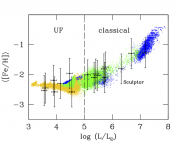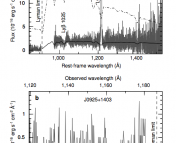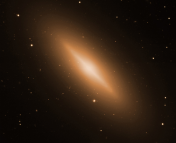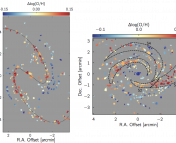Title: AGB stars as tracers of metallicity and mean age across M33
Authors: M.-R.L. Cioni, M. Irwin, A.M.N. Ferguson, A. McConnachie, B.C. Conn, A. Huxor, R. Ibata, G. Lewis, N. Tanvir
First Author’s Institution: Centre for Astrophysics Research, University of Hertfordshire, Hatfield AL10 9AB, UK
Status: Published in Astronomy & Astrophysics [open access]
Asymptotic Giant Branch (AGB) stars are among the brightest and coolest stars in the Universe. All stars with masses less than 8 M☉ will eventually evolve into the Asymptotic Giant Branch, the last phase of a star’s life. AGB stars have carbon-oxygen degenerate cores surrounded by helium and hydrogen-burning shells. In comparison, our Sun, a main sequence star, is primarily made of hydrogen being fused into helium. AGB stars are also much larger and brighter than the Sun; sometimes up to thousands of times brighter!
AGB stars can generally be sorted into two types: oxygen-rich (M-type) or carbon-rich (C-type). Oxygen-rich AGB stars have a carbon-to-oxygen (C/O) ratio in their atmospheres of less than one, whereas carbon-rich AGB stars have C/O ratios greater than one. Oxygen-rich AGB stars span a narrow range of color but large range in luminosity (the amount of energy radiated by an object per second), whereas carbon-rich AGB stars span a wide range of color but an approximate constant luminosity. These observational effects are due to the absorption effects of molecules in the star’s atmosphere. To differentiate between C-type and M-type AGB stars, the authors of this paper used their near-infrared color as a delineator. For example, in Figure 1, the dashed vertical line at (J-K)=1.36 cleanly separates the two stellar populations.
Using AGB stars to probe metallicity in the galaxy M33
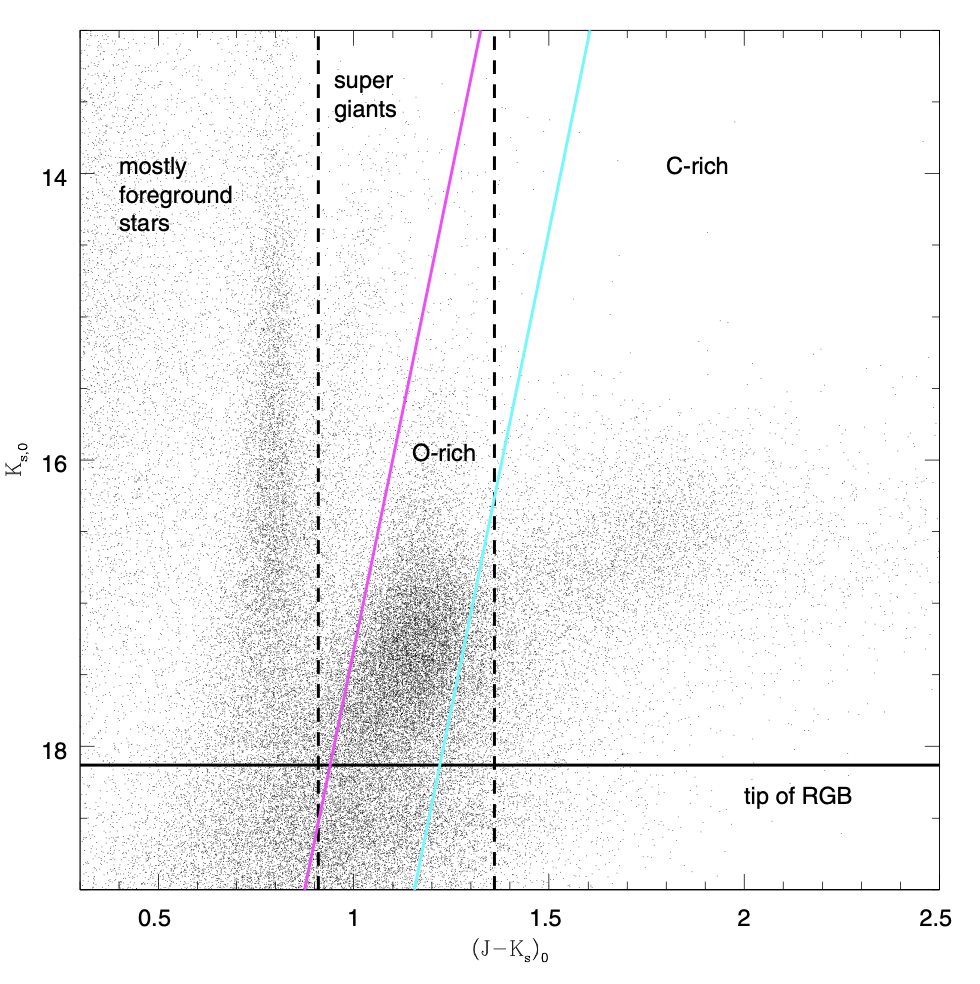
Because AGB stars are so red, they are best studied in the redder near-infrared wavelengths. Therefore, studying AGB stars was difficult until the advent of the improved infrared technology of the 2000s (before this, near-infrared telescopes were not good enough to study stellar populations). This paper capitalized on imaging from the 3.8-m United Kingdom InfraRed Telescope (UKIRT) in Hawaii to study the AGB stars in M33, or the Triangulum Galaxy. M33 is a spiral galaxy and the third largest member of the Local Group, the galaxy group also consisting of the Milky Way (2nd largest) and the Andromeda Galaxy (largest).
This paper used the AGB stars in M33 to study how the metallicity varies over the galaxy, in other words, its metallicity gradient. The ratio of carbon-rich to oxygen-rich AGB stars (C/M) is a tracer of metallicities in galaxies, because in low metallicity environments, there are more C-rich stars. This is because carbon-rich AGB stars more easily form in low metallicity environments. Therefore, a higher C/M ratio indicates a lower metallicity. By counting the relative ratios of carbon-rich to oxygen-rich AGB stars, the metallicity gradient in a galaxy can be derived.
The authors divided M33 into 40 different sectors, and determined the ratio of C/M stars in each sector. In Figure 2, the distribution of the C/M ratio throughout M33 is shown. The C/M ratio measured in this paper confirmed that M33 has a metallicity gradient, where the metallicity decreases with galactic radius, except for a broad outer ring in the galaxy which has a high metallicity.
Using AGB stars to probe age
The C/M ratio can also be used to probe the mean age throughout a galaxy. Carbon-rich AGB stars have very narrow age ranges (200 Myr to 4 Gyr) whereas oxygen-rich AGB stars have a much broader age range (55 Myr to 13 Gyr). Therefore, in addition to metallicity, different star formation rates could also affect the relative numbers of carbon and oxygen-rich AGB stars. The authors found that the C/M ratio was a tracer of the mean age of the C-rich and O-rich AGB stars. They did so by fitting the distributions of these stars with theoretical stellar evolution models. In general, they found that younger stellar populations will produce more M-type AGB stars than C-type AGB stars.

In conclusion, the authors found that this C/M ratio was a robust probe of the metallicity and age in the nearby galaxy M33. Because AGB stars are among the brightest stars in a galaxy, this method can be extended to farther galaxies as long as the AGB stars can be observed. This is significant because usually metallicities of galaxies are probed using main-sequence stars, which are much fainter than AGB stars and can therefore only be seen at smaller distances.
Astrobite edited by Junellie Gonzalez Quiles
Featured image credit: European Space Agency

